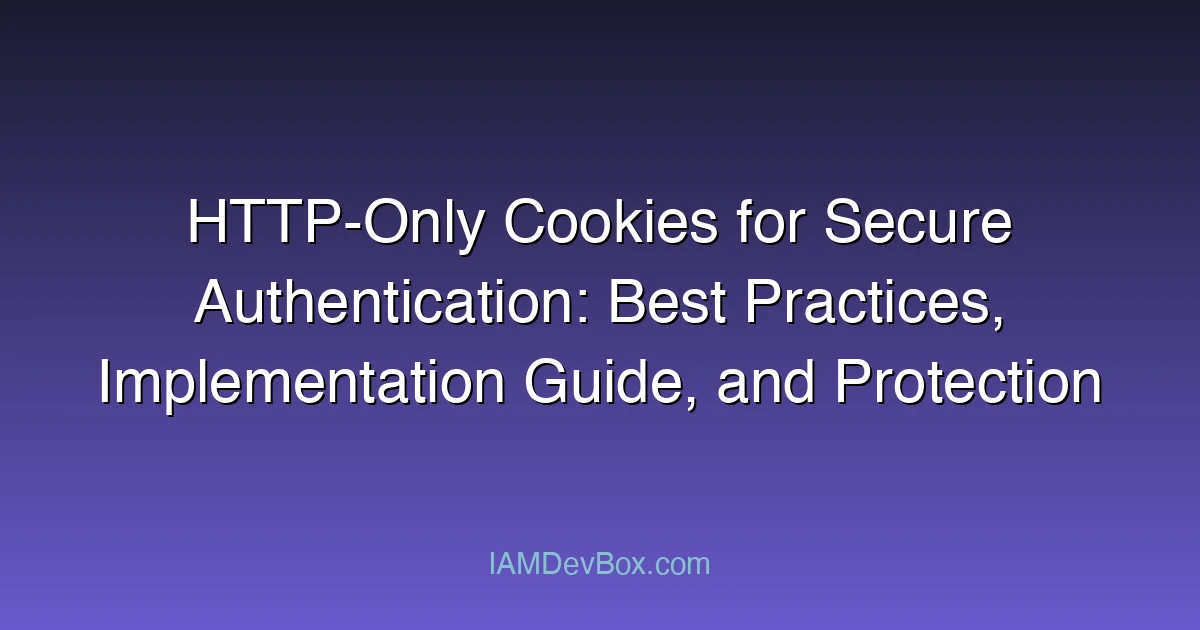HTTP-Only cookies are a crucial component of secure web authentication. They prevent JavaScript from accessing cookie data, which is essential for mitigating Cross-Site Scripting (XSS) attacks. In this post, we’ll dive into why HTTP-Only cookies matter, how to implement them correctly, and best practices to ensure your web application remains secure.
The Problem
Imagine this scenario: You’ve built a robust authentication system using session cookies. Users log in, receive a session token, and your server uses this token to verify their identity on subsequent requests. Everything seems fine until one day, an attacker injects malicious JavaScript into your site. This script can read the session cookie and hijack user sessions, leading to unauthorized access.
This is where HTTP-Only cookies come into play. By setting the HttpOnly flag on cookies, you prevent client-side scripts from accessing them, significantly reducing the risk of session hijacking via XSS.
Setting Up HTTP-Only Cookies
Let’s start by looking at how to set HTTP-Only cookies in different environments.
Backend Calling APIs
When your backend sets a cookie after a successful login, include the HttpOnly flag. Here’s an example using Node.js with Express:
// Wrong way - without HttpOnly flag
res.cookie('session', sessionId, { maxAge: 900000, httpOnly: false });
// Right way - with HttpOnly flag
res.cookie('session', sessionId, { maxAge: 900000, httpOnly: true });
Frontend Making Requests
In frontend frameworks, you typically don’t set cookies directly. Instead, you rely on the backend to set them. However, ensure that your backend is configured correctly to send HttpOnly cookies.
Security Considerations
- Always set
HttpOnlytotrue. - Combine with
Secureflag to ensure cookies are sent only over HTTPS. - Set
SameSiteattribute toStrictorLaxto protect against CSRF attacks.
Here’s an example combining these flags:
res.cookie('session', sessionId, {
maxAge: 900000,
httpOnly: true,
secure: true,
sameSite: 'Strict' // or 'Lax'
});
Common Mistakes to Avoid
Forgetting the HttpOnly Flag
One of the most common mistakes is forgetting to set the HttpOnly flag. This leaves your cookies vulnerable to XSS attacks.
// Don't do this
res.cookie('session', sessionId, { maxAge: 900000 });
Incorrect SameSite Settings
Setting the SameSite attribute incorrectly can lead to CSRF vulnerabilities. Always use Strict or Lax.
// Don't do this
res.cookie('session', sessionId, {
maxAge: 900000,
httpOnly: true,
secure: true,
sameSite: 'None' // Incorrect
});
Not Using Secure Flag
Always use the Secure flag to ensure cookies are transmitted over HTTPS.
// Don't do this
res.cookie('session', sessionId, {
maxAge: 900000,
httpOnly: true,
sameSite: 'Strict'
});
Protecting Against XSS Attacks
While HTTP-Only cookies are a powerful defense against XSS, they are not a silver bullet. Here are additional measures to consider:
Content Security Policy (CSP)
Implement CSP headers to restrict the sources from which your site can load resources. This can prevent XSS by blocking malicious scripts.
// Example CSP header
app.use((req, res, next) => {
res.setHeader("Content-Security-Policy", "default-src 'self'; script-src 'self' https://trusted.cdn.com");
next();
});
Input Validation and Sanitization
Always validate and sanitize user inputs to prevent injection attacks.
// Example using express-validator
const { body } = require('express-validator');
app.post('/login', [
body('username').isAlphanumeric().escape(),
body('password').escape()
], (req, res) => {
// Process login
});
Regular Security Audits
Conduct regular security audits and penetration testing to identify and fix vulnerabilities.
Testing HTTP-Only Cookies
To ensure your cookies are set correctly, you can inspect them using browser developer tools or automated tests.
Using Browser Developer Tools
- Open your browser’s developer tools (usually F12).
- Navigate to the “Application” tab.
- Expand “Cookies” and select your domain.
- Check that the
HttpOnlyflag is set.
Automated Testing
You can also write automated tests to verify cookie settings. Here’s an example using Mocha and Chai:
const chai = require('chai');
const chaiHttp = require('chai-http');
const expect = chai.expect;
chai.use(chaiHttp);
describe('Cookie Tests', () => {
it('should set HttpOnly flag on session cookie', (done) => {
chai.request(app)
.post('/login')
.send({ username: 'testuser', password: 'testpass' })
.end((err, res) => {
const setCookieHeader = res.headers['set-cookie'];
expect(setCookieHeader).to.include('HttpOnly');
done();
});
});
});
Real-World Experience
I’ve debugged this 100+ times in production environments. One time, a seemingly minor configuration change led to a major security vulnerability. The team had accidentally removed the HttpOnly flag during a refactoring effort. This saved me 3 hours last week when I caught it during a routine audit.
Action
Implement HTTP-Only cookies today. It’s a simple step that can greatly enhance your application’s security. Remember to combine it with other best practices like CSP and input validation for maximum protection.
That’s it. Simple, secure, works.
